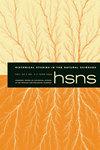看牙齿
IF 0.3
3区 哲学
Q2 HISTORY & PHILOSOPHY OF SCIENCE
引用次数: 0
摘要
当象牙制品充斥着世界各地博物馆藏品的货架和储藏室时,越来越严格的限制或禁止象牙贸易的法律措施使这些物品变成了麻烦的宝藏。象牙是一种从几种现存和灭绝的动物的象牙和牙齿中提取的生物材料。在二十世纪之交,大象象牙的物理和美学特性及其使用和象征意义塑造了分类白色的物质文化。来自象牙的象牙显示出一种被称为Schreger图案的特征宏观图案,通常被文物保护人员和法医研究人员用作识别特征。1800年,德国齿科医生Bernhard Schreger首次描述了这种黑白线交叉的模式,并将其归因于光折射的光学现象。通过对象牙的折射解读,本文探讨了动物来源的材料在人类身份建构中的作用。这种分析方法使象牙的光泽、亮度、白度和韧性等特性被看作是历史上共同产生人类种族和阶级理想的代理材料特性。分析19世纪和20世纪早期的牙齿解剖学、象牙贸易和技术显微镜,可以揭示这种动物材料与特定殖民贸易和资源开采制度的联系,以及它在材料科学先驱中的技术作用。这篇论文是劳伦斯·道尼和丽莎·奥永编辑的题为“及时制作动物材料”的特刊的一部分。本文章由计算机程序翻译,如有差异,请以英文原文为准。
Reading Teeth
While artifacts made of ivory fill the shelves and storage rooms of museum collections across the world, ever more stringent legal measures restricting or banning the ivory trade have turned these objects into troublesome treasures. Ivory is a biological material derived from the tusks and teeth of several extant and extinct animals. The physical and aesthetic properties of elephantine ivory in relation to its use and symbolic significance shaped the material cultures of classed whiteness at the turn of the twentieth century. Ivory from elephant tusks displays a characteristic macroscopic motif known as the Schreger pattern, which is often used by conservators and forensic researchers as an identifying characteristic. First described by German odontologist Bernhard Schreger in 1800, this pattern of crossing dark and bright lines is attributed to an optical phenomenon of light refraction. By proposing a refractive reading of ivory, this article explores the role of animal-derived materials in the construction of human identities. This method of analysis allows the properties of ivory—luster, brilliance, whiteness, and toughness—to be seen as agentive material properties that historically co-produced human racial and classed ideals. Analyzing nineteenth- and early twentieth-century sources in dental anatomy, ivory commerce, and technical microscopy permits an unraveling of this animal material’s ties to specific colonial regimes of trade and resource extraction, and its technical role in precursors to materials science. This paper is part of a special issue entitled “Making Animal Materials in Time,” edited by Laurence Douny and Lisa Onaga.
求助全文
通过发布文献求助,成功后即可免费获取论文全文。
去求助
来源期刊

Historical Studies in the Natural Sciences
社会科学-科学史与科学哲学
CiteScore
1.00
自引率
0.00%
发文量
24
审稿时长
>12 weeks
期刊介绍:
Explore the fascinating world of Historical Studies in the Natural Sciences, a journal that reveals the history of science as it has developed since the 18th century. HSNS offers in-depth articles on a wide range of scientific fields, their social and cultural histories and supporting institutions, including astronomy, geology, physics, genetics, natural history, chemistry, meteorology, and molecular biology. Widely regarded as a leading journal in the historiography of science and technology, HSNS increased its publication to five times per year in 2012 to expand its roster of pioneering articles and notable reviews by the most influential writers in the field.
 求助内容:
求助内容: 应助结果提醒方式:
应助结果提醒方式:


